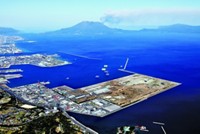Advertisement
Grab your lab coat. Let's get started
Welcome!
Welcome!
Create an account below to get 6 C&EN articles per month, receive newsletters and more - all free.
It seems this is your first time logging in online. Please enter the following information to continue.
As an ACS member you automatically get access to this site. All we need is few more details to create your reading experience.
Not you? Sign in with a different account.
Not you? Sign in with a different account.
ERROR 1
ERROR 1
ERROR 2
ERROR 2
ERROR 2
ERROR 2
ERROR 2
Password and Confirm password must match.
If you have an ACS member number, please enter it here so we can link this account to your membership. (optional)
ERROR 2
ACS values your privacy. By submitting your information, you are gaining access to C&EN and subscribing to our weekly newsletter. We use the information you provide to make your reading experience better, and we will never sell your data to third party members.
Business
Japan's Industry Stands Strong
Natural Disaster: Many firms resume operations as buyers make supply chain adjustments
by Jean-François Tremblay
April 1, 2011
| A version of this story appeared in
Volume 89, Issue 14

Supplies of electronic materials from Japan may bounce back more quickly than previously thought. Japanese producers this week are showing good progress in recovering from the March 11 earthquake and tsunami as buyers in turn began adjusting their sourcing patterns.
Still, plants close to the quake’s epicenter will likely take several more months to resume operations, say firms with operations in that broad area.
Mitsubishi Gas Chemical expects to restart production in early May at a plant in Fukushima prefecture that makes bismaleimide triazine resin. The plant produces about 50% of the world’s output of the material, which is important for making printed-circuit boards.
Depending on their buying clout, component producers may be able to sail through the resin supply disruption, says Andrew Lu, a Hong Kong-based semiconductor industry analyst at Barclays Capital. Major users such as Qualcomm and Mediatek “will not even feel a thing,” he predicts. But Lu warns that smaller firms will likely stop production for as long as two months.
Another electronic materials producer, JX Nippon Mining & Metals, says its indium tin oxide targets plant in Ibaraki prefecture will resume shipments in late May. The company is the world’s largest producer of ITO targets, which are used to make liquid-crystal displays.
Meanwhile, Shin-Etsu Chemical can’t properly inspect its downed silicon wafer plant in Fukushima prefecture because of aftershocks, a spokesman says. The facility produces 20% of the world’s supply of the semiconductor building block, according to the electronics market research firm IHS iSuppli.
But this outage won’t be a problem, Barclays’ Lu anticipates. He expects that other companies will be able to pick up Shin-Etsu’s share, which he believes is less than 20% of the world’s wafer supply.
Outside the electronics industry, Merck KGaA says a pigment plant in Fukushima prefecture will remain down for some time. The facility makes a pigment called Xirallic, used in car coatings. The material was developed in Japan and has been produced only at the Fukushima plant, Merck says. Production will restart within eight weeks of the power grid and roads being repaired, the firm anticipates.



Join the conversation
Contact the reporter
Submit a Letter to the Editor for publication
Engage with us on Twitter